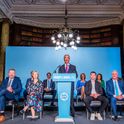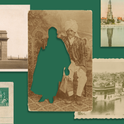Why have the political trajectories of India and Pakistan been so different, given that each was cut from the nearly identical cloth of empire? If the characteristics of a resilient democracy include pluralism, control over defined territory, a sense of being one nation and, for poor countries, the ability to develop—then it seems to have taken India about 30-35 years to become one, from the early 1940s to the late 1970s. Pakistan, by contrast, remains far from the democratic goal.
But from the outset in 1947, there were several factors which favoured India over Pakistan. The basis for founding Pakistan was the protection of a religious group, while for India it was national self-determination. Given the extent of ethnic, linguistic and religious difference, India was pluralistic from the start. Pakistan, however, was premised on the idea that Islam would be in danger in an independent Hindu majority state, particularly if it was to be a democracy. The numbers could not favour Muslims—who made up only about 10 per cent of India's pre-partition population. The result of the campaign for a separate Muslim homeland was that as partition drew closer, large numbers of Muslims who had lived across India moved to the provinces of northwest India, to settle amid different ethnic and linguistic communities.
These communities, in the North West Frontier Province (NWFP) and Punjab, had historically been among the least exposed to democracy and pluralism under British rule, as they had comprised the security perimeter of British India. They were heavily militarised, as the "steel frame" had to be maintained against the Russian empire. The third of what came to be Pakistan's four provinces was Balochistan. It was created late in the 1880s, and was made up of mainly princely states, with entrenched authoritarian aristocratic rulers. Sindh, the fourth province, which hosted the port city of Karachi, had a rural interior with large tracts of land owned by "waderas" or feudal lords—the Bhutto family alone was estimated to own 40-60,000 acres of prime land, worked by serfs.
The relative lack of political and economic development in what was west Pakistan resulted in the main party—Jinnah's Muslim League—being dominated by the newly arrived Indian-born, Urdu-speaking elite. The military, on the other hand, were indigenous to the land—in 1947, 77 per cent of the army came from Punjab and a further 19 per cent from NWFP. This made the subservience of the military to the political class that is normal in democracies difficult to achieve in Pakistan from the outset (and the Punjabi domination of the military has not changed).

Despite its huge diversity, India did not fragment. The national organisational base of the first ruling party, Congress, combined with a clear expectation that the governance structure would be a parliamentary democracy, resulted by 1950 in a secular constitution organised on a federal basis with 28 provinces. The constitution has served India well, and although Nehru's family, the Gandhis, have dominated politics, they have been removed from office through the ballot box on successive occasions. Many other parties have emerged, and different political and economic models have been allowed across the provinces. Leaving aside the struggles for Kashmiri independence and a Sikh homeland, the country has never come close to breaking up, and the external threat from the smaller Pakistan has never been existential.
Pakistan, by contrast, has never been able to mould its diversity into a coherent national identity. Its early ruling elite were migrants, and half the country—East Pakistan (formerly east Bengal)—was territorially separated by 1,000 miles across a hostile neighbour. East Pakistan had the larger population, and Bengalis were more ethnically, linguistically and culturally homogenous than west Pakistanis. The differences between east and west took precedence over national solidarity. In Pakistan's first fully democratic election in 1970, the Awami League—the majority Bengali political party—won, but its victory was not recognised by ZA Bhutto (father of the late Benazir), leader of the Sindh-based Pakistan People's party (PPP), which came second. A civil war ensued, in which India intervened on the side of East Pakistan (now Bangladesh) and the Pakistani army was routed. Democracy, in this case, resulted in secession—and the security imperative created a special role for the military thereafter.
But why has Pakistan not embraced democracy since the 1970s? The military blames the venality of the political classes, which it says cannot be trusted to rule in the national interest. There is something in this. Politicians are still drawn from a conservative, authoritarian landowning elite, who bring personal "vote banks" with their family names. While some of these characteristics are found in India too, India has had entrenched, mass-based political organisation for nearly a century now, and a political elite that has shared power quite widely. This has resulted in much greater middle-class and non-elite participation in politics than in Pakistan. Moreover, India adopted a secular liberal-democratic constitution early, with institutional structures based on a separation of powers. This gave it the resilience to withstand Indira Gandhi's emergency rule in the 1970s. Pakistan, by contrast, struggled for nine years to agree its first constitution, ending with a messy compromise. Now on its third, much-amended constitution, Pakistan has moved away from a parliamentary style to a hybrid presidential-parliamentary framework which builds in tensions and power struggles. The instability created by a president's ability to dismiss an elected government, combined with the military's readiness to step in, has created a "winner takes all" political culture within both the military and the political classes.
Moreover, in Pakistan no single party has been able to transcend ethnic and linguistic communalism to command a majority across the country. Parties operate on the basis of regional strongholds, with the PPP doing best in Sindh, and the Pakistan Muslim League (Nawaz) strongest in the Punjab, where its main rival is Musharraf's party, Pakistan Muslim League (Quaid). Karachi, the commercial centre with a population of some 18m, absorbed a large number of Indian Muslim migrants and hence votes on the whole for an Urdu-speaking party, the MQM. People in the NWFP and Balochistan—the areas with the least economic development, and strong tribal structures—traditionally voted for nationalist parties. This has given way in recent elections to support for Islamist parties. Other parts of the country are "federally administered tribal areas," which have no political organisation and where the writ of the state is exercised through a government representative.
An artificial state defined by religion, weak institutions, communal groups unable to subsume their narrow interests, a very small middle class and rising jihadi extremism—these are not promising ingredients for democracy. This is why the military still holds the cards. But the demands in Pakistan for democracy appear to be stronger than in the past, and Musharraf would do well to allow significant political autonomy to whoever becomes prime minister after the elections in mid-February. But the role of the army in running Pakistan will not be easily phased out. Geopolitics and broken institutional structures have not created a country suited to full civilian rule. When he took power in 1999, Musharraf was clearly interested in the "Turkish compromise"—where, until recently, governance on key matters was done in consultation with a national security council, in which the heads of the armed forces had a say. This may still be the least worst option for Pakistan, as it will provide a role for the military while allowing room for democratic growth. In time, a civic political culture could slowly emerge.











